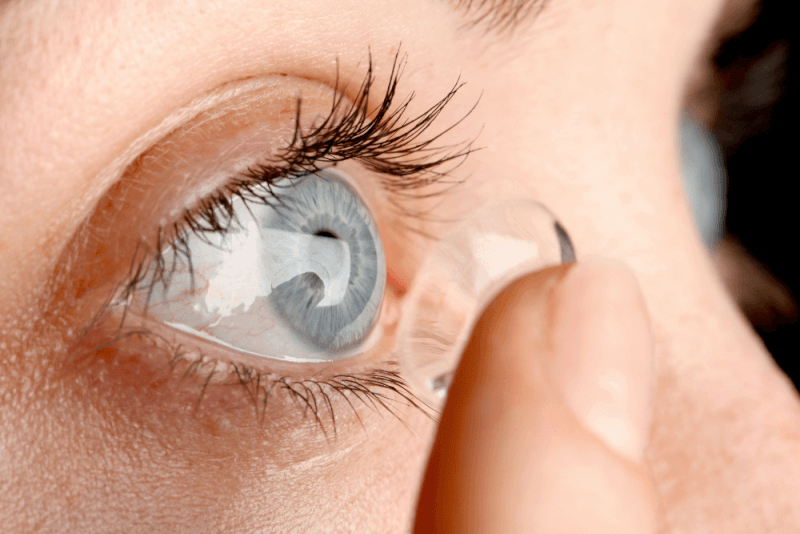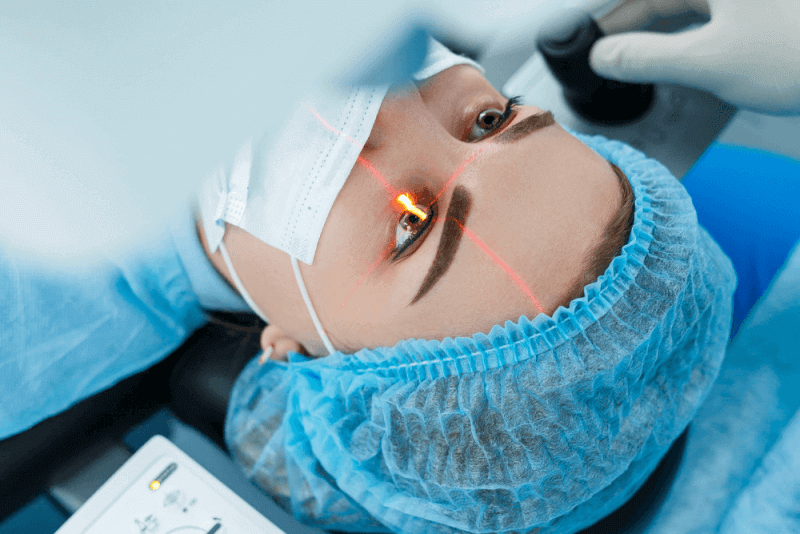What are Contact Lenses?
Contact lenses are used to correct refractive errors in the eye and are placed on the front surface of the cornea. Contact lenses are not only used to correct vision problems but are also cosmetic lenses. As one type of prosthesis, contact lenses are placed on the corneal surface, not only correcting certain vision problems but also aiding in the treatment of some eye diseases.
How to Use Contact Lenses?
If contact lenses are to be used for vision correction or eye diseases, an eye examination must be performed first, and the most suitable contact lens for the patient should be prescribed. After the evaluation, it should also be determined whether the eye structure is suitable for contact lens use. Finally, determining the type of contact lens to be used by the patient will ensure maximum benefit from contact lens use.
When starting to use contact lenses, they should be worn for limited periods during the day. The duration of use is then gradually increased. The adaptation process varies depending on the hardness of the lens. The adaptation period for soft lenses is completed in 3-4 days, while it may take up to 4 weeks for hard lenses. During this period, symptoms such as light sensitivity, blinking, tearing, and redness are normal. These complaints are usually temporary, but if they persist for a long time, a doctor should be consulted.
Advantages of Contact Lenses
If contact lenses are properly selected and used correctly, the following advantages can be offered:
- Allows for more comfortable sports and exercise.
- Provides a wider field of view compared to glasses.
- Enhances depth perception.
- Avoids issues like fogging, which occurs with glasses.
- Since there is no frame, the view is not obstructed.
Risks of Contact Lenses
Failure to use contact lenses according to instructions can lead to certain risks. The risks associated with contact lens use include:
Corneal Infections
This condition is commonly seen in individuals with corneal ulcers or keratitis. Factors that can lead to keratitis include:
- Improper use of lenses.
- Failure to properly clean the lenses.
- Using lenses beyond their lifespan.
- Continuing to use lenses during periods when certain eye diseases, such as conjunctivitis, are present.
- Having advanced cancer that affects the immune system.
Dry Eyes
Dry eyes are especially common in people who use soft lenses. When the water content in the lenses decreases, they often cause irritation. In addition, activities such as computer use, which reduces the frequency of blinking, can also lead to dry eyes.
Allergies
Solutions used with lenses, dust accumulated on lenses, or prolonged use of lenses can cause allergies.
Who Can Use Contact Lenses?
Contact lenses are theoretically prostheses that can be used by anyone. However, to ensure they do not harm the eyes and are comfortable to use, the following characteristics should be present in users:
- Normal external eye structure.
- Normal external eyelid structure.
- No deficiency in tear production.
- No chronic eye infections.
- No need for continuous use of eye medication.
How to Choose Contact Lenses?
Contact lenses should be chosen based on the prescription provided by a doctor. In addition to correctly correcting the visual defects identified during an eye examination, the curvature of the eye and the diameter of the lenses should be determined to ensure that the prescribed contact lenses provide maximum benefit. It is also recommended to obtain the necessary instructions from the doctor regarding the duration of use and how to use the lenses.
How Should Contact Lenses Be Maintained?
The primary consideration in the maintenance of contact lenses is the type of lens being used. Single-use and long-term soft lenses require the least amount of maintenance among lens types. General care instructions for lenses include:
- Before putting on lenses, hands should be washed with mild soap. Hands should not have any perfume, oil, or lotion on them. If these substances come into contact with the lenses, they may irritate the eyes or cause blurry vision.
- Hands should be dried with a clean, lint-free towel.
- Eye makeup should be applied after putting on the lenses.
- Hair spray should be used before putting on the lenses.
- Some contact lenses require special care. Therefore, it is always necessary to follow the care instructions recommended by the doctor.
- The cleaning of lenses can be done using disinfectant solutions, eye drops, and enzymatic cleaners recommended by the doctor.
- Lenses should not be washed with tap water. Even filtered water can cause eye infections. Therefore, water use is not recommended for cleaning lenses.
- When cleaning contact lenses, they should be gently rubbed in the palm with the recommended cleaning solution using the index finger. The lens case should be cleaned after each use.
- The lens case should be cleaned with sterile water solution and then allowed to air dry.
- It is recommended to replace lens cases every 3 months.
What Should Be Considered When Using Contact Lenses?
To use contact lenses safely, the following points should be considered:
- Lenses should only be worn for the duration recommended by the doctor.
- Attention should be paid to the replacement times of lenses. If it is difficult to remember these times, a schedule can be prepared.
- Do not use contact lenses belonging to someone else.
- If long-term lenses are not being used, do not sleep with them on. This is because, with the eyes closed, there is not enough oxygen.
- The tips of solution bottles should not touch hands, contact lenses, or other objects.
- When going out in the sun, UV-protected sunglasses or a hat should be worn.
- Use solutions recommended by the doctor to keep the eyes moist.
- Wearing contact lenses inside out does not harm the eye, but it may feel uncomfortable.
- If the eyes become irritated, the lenses should be removed. They should not be used again until the irritation subsides.
- In case of sudden vision loss, persistent blurry vision, light flashes, pain, infection, swelling, unusual redness, or irritation, consult a doctor immediately.
- Do not swim with contact lenses.
Types of Contact Lenses
Contact lenses are generally divided into two main types: gas-permeable hard lenses and soft lenses. While the use of hard lenses is very limited, soft lenses are commonly used.
Soft Lenses
Also known as hydrogel lenses, these are used to correct refractive errors. Soft lenses, made from special materials that can retain water, are extremely thin and flexible. Soft lenses, which completely cover the cornea, have varying lifespans.
Hard Contact Lenses
Hard lenses can be used in all areas where soft lenses are used. However, hard lenses are usually preferred in cases of high and irregular astigmatism or when the corneal surface is irregular due to keratoconus. Hard lenses allow oxygen to enter the eye, thus reducing the degradation of the corneal epithelial tissue. Due to their rigid structure, they do not conform to the shape of the cornea, making them ideal for conditions such as astigmatism and keratoconus.
Colored Lenses
The primary purpose of colored lenses is to change eye color, which is why they are mainly chosen for cosmetic purposes. However, colored lenses can also correct refractive errors.
Bifocal Lenses
These contact lenses are suitable for individuals with both near and far vision problems.
Types of Contact Lenses
Contact lenses are classified into various subtypes based on their duration of use and purpose. The types of contact lenses include:
Daily Lenses
The duration of use for contact lenses varies. The shortest duration is for daily lenses, also known as disposable lenses. A new lens is used every day, and the lens is discarded at the end of the day.
Monthly Lenses
Monthly lenses have a 30-day usage period. After this period, the lenses should no longer be used. A box of monthly lenses generally contains 6 lenses. If the prescription for both eyes is the same, one box of lenses provides a 3-month supply. However, if the prescriptions are different, two boxes of monthly lenses are required.
Toric Lenses (Astigmatism)
Toric lenses, also known as astigmatism lenses, correct astigmatism by allowing light to refract differently, focusing light on two different points on the retina. In addition to toric contact lenses, intraocular toric lenses are also available.
Overnight Lenses
Lenses worn while sleeping help reshape the cornea, eliminating the need for lenses or glasses during the day.
Pediatric (Aphakic Lenses)
Pediatric lenses are prescribed for children who have undergone cataract surgery and have aphakia. These lenses help improve vision in infants and children.
High-Powered Lenses
These lenses correct refractive errors in the eye, addressing issues such as myopia and hyperopia, and are also used for astigmatism.







